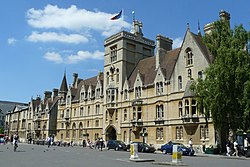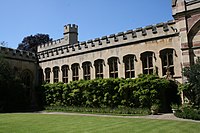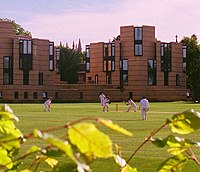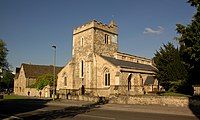Balliol College, Oxford
| Balliol College Latin: Collegium Balliolensis
| ||||||||||||

| ||||||||||||
|---|---|---|---|---|---|---|---|---|---|---|---|---|
 | ||||||||||||
| Principal: | ||||||||||||
| Website: | https://www.balliol.ox.ac.uk/ | |||||||||||
| ||||||||||||
| Location | ||||||||||||
| Grid reference: | SP513065 | |||||||||||
| Location: | 51°45’17"N, 1°15’28"W | |||||||||||
Balliol College is a constituent college of the University of Oxford.[1] Founded in 1263 by John I de Balliol,[2] it has a claim to be the oldest college in Oxford and the English-speaking world.[3]
Members of Balliol have been awarded 13 Nobel Prizes with 12 Laureates (the most of any Oxford college).[4][5] Balliol has educated four Prime Ministers of the United Kingdom (the second highest of any Oxford college), Harald V of Norway,[6] Empress Masako of Japan, and leading staement and scientists of the world.
History
Foundation and origins
Balliol College was founded in about 1263 by John I de Balliol under the guidance of Walter of Kirkham, the Bishop of Durham.[7] According to legend, the founder had abducted the bishop as part of a land dispute and as a penance he was publicly beaten by the bishop and had to support a group of scholars at Oxford.[8] After de Balliol's death in 1268, his widow, Dervorguilla of Galloway (their son and grandson each became Kings of Scotland), made arrangements to ensure the permanence of the college in that she provided capital and in 1282 formulated the college statutes, documents that survive to this day.
Balliol lays claim to being the oldest Oxford college, though this is disputed by both University College and Merton. Balliol's claim is that a house of scholars was established by the founder in Oxford in around 1263, in contrast to Merton, which was the first college to be granted an official statute in 1274, and University College, which, while provisionally founded by will in 1249, was only officially established around 1280. However, Balliol also acknowledges that the other two have legitimate claims on their respective bases, depending on what criteria are used to define the oldest.[9][10]
New Inn Hall
Under a statute of 1881, New Inn Hall, one of the remaining mediæval halls, was merged into Balliol College in 1887.[11] Balliol acquired New Inn Hall's admissions and other records for 1831–1887[12] as well as the library of New Inn Hall, which largely contained 18th-century law books.[11] The New Inn Hall site was later sold and is now part of St Peter's College, Oxford.
The Masque of Balliol
In 1880, seven mischievous Balliol undergraduates published The Masque of B-ll--l, a broadsheet of forty quatrains making light of their superiors – the master and selected fellows, scholars, and commoners – and themselves. The outraged authorities immediately suppressed the collection, and only a few copies survived, three of which found their way into the college library over the years, and one into the Bodleian Library. Verses of this form are now known as Balliol rhymes.
The best known of these rhymes is the one on Benjamin Jowett. This has been widely quoted and reprinted in virtually every book about Jowett and about Balliol ever since:
First come I.
My name is J-W-TT.
There's no knowledge but I know it.
I am Master of this College,
What I don't know isn't knowledge.
This and 18 others are attributed to Henry Charles Beeching. The other quatrains are much less well known.
William Tuckwell included 18 of these quatrains in his Reminiscences in 1900, but they all came out only in 1939, thanks to Walter George Hiscock, an Oxford librarian, who issued them personally then and in a second edition in 1955.[13]
Women at Balliol
For over 700 years, Balliol College admitted men only. New College had in 1964 resolved to admit women, but had been prevented from doing so without the approval of the university, which argued that this would be detrimental to the existing women's colleges. On 2 June 1971, a consilium at Balliol voted 26–2 to admit women, and at the next college meeting on 6 December 1971 it was resolved 30–8 to admit women "as soon as the change in its Statutes permitting this was approved by the Privy Council". Permission was granted by the university on 8 March 1977. With the appointment of Carol Clark to a Tutorial Fellowship in Modern Languages in 1973, Balliol became the first ancient all-male college to appoint a female fellow.[14]
Before the full admission of women as undergraduates, the college had decided to establish a co-educational graduate institution. The decision was made on 16 March 1964, and the senior tutor approached St Anne's College shortly after this. The creation of the Balliol–St Anne's Graduate Institution with St Anne's in 1967 led to the coeducation of men and women on the Holywell Manor site. Following the arrival of women at Balliol and men at St Anne's in 1979, the joint Graduate Institution was terminated in 1984 by the consent of both colleges. Holywell Manor is now solely a part of Balliol College.
In 1979, along with many other previously all-male colleges, Balliol accepted its first cohort of female students.[15] One of the first woman undergraduates to live at Balliol was Elena Ceva-Valla, who arrived on 16 September 1979. Other female undergraduates who arrived that term were Cressida Dick, Katy Koralek and Penny Phillips. In 2010, the college unveiled a sundial in the Garden Quad commemorating the thirtieth anniversary of the admission of women to the college,[16] inscribed with the phrase "About Time". The first portrait of a woman in Hall since that of the co-founder, Dervorguilla of Galloway, was unveiled in 2012, depicting benefactor and Oxford Internet Institute founder Dame Stephanie Shirley.[17] This portrait has since been joined by portraits of Carol Clark and the mathematician Dame Frances Kirwan.[18][19]
Buildings and grounds


The college has been on its present site since its inception by Balliol's scholars as their residence with a lease dating to 1263 to them being the traditional "foundation" date.
Front quadrangle


The oldest parts of the college are the north and west ranges of the front quadrangle, dated to 1431, respectively the mediæval hall, west side, now the "new library" and the "old library" first floor north side. The ground floor is the Old Senior Common Room. Balliol's second library pre-dates the publication of printed books in Europe. There is a possibility that the original Master's Chamber, south west side, adorned with a fine oriel window, is earlier than these; it is now the Master's Dining Room.
William Grey, Bishop of Ely, was a benefactor of the college in the 15th century. Grey devoted much care to the collection of manuscripts, and wherever he resided constantly employed scribes to make copies of such books as he could not otherwise obtain. Many of these he had adorned with costly miniatures and initial letters by the skill of an artist who worked for him at Florence. It was his desire to make his collection the nucleus of a library for Balliol College, to the building of which, as well as to that of the master's lodgings and of the old buttery and hall, he contributed largely. The work was finished about 1477 by Robert Abdy, then master of the college, and enriched with some two hundred manuscripts, the bishop's gift. Of these, many were destroyed in the reign of Edward VI and during the great rebellion, and by Wood's time few of the miniatures in the remaining volumes had escaped mutilation. But by 1890, no less than 152 of Grey's codices were still in the possession of the college, and form a large part of Roger Mynors's 1963 catalogue of the college's manuscripts.[20] The bishop's coat of arms (gules, a lion rampant, within a bordure engrailed argent) is displayed on two windows of the Old Library, and in the panels below the window of the Master's dining room. The chapel is the third (perhaps fourth) on the site and was designed by William Butterfield in 1857.
Alfred Waterhouse designed the main Broad Street frontage of the college (1867–68), along with gateway and tower, known as the Brackenbury Buildings after philanthropist and donor Hannah Brackenbury, replacing earlier structures (Staircases I–VII). The first staircase next to the Chapel contains the Organ Scholar's lodgings.
Garden Quadrangle
South-side is the front part of the Master's Lodgings on Broad Street from the Waterhouse improvements of the 1860s of the front quad. The neighbour to this is the Fisher Building of 1759 (Stc X) The undistinguished looking Stc XI, south west side, is in fact the oldest structure in this quadrangle, 1720, originally intended as accommodation for scholars from Bristol, hence its name. Continuing the west-side Stc XII–XIV dates from 1826, by George Basevi, and marks the beginnings of the college's academic renaissance being required for the increasing number of Commoners applying for places. Stc XV by Warren of 1912 filled in the last gap of the quadrangle; the ground floor and basement is the principal Junior Common Room. This unfortunately obscures the lines of the Salvin designed Stc XVI–XIX with Tower of 1853. As does the 1968 building by Beard Stc XX, replacing a Victorian structure. This completely hides a formal gateway similar to that at the Broad Street main entrance, this can be viewed outside from Little Magdalen Street, through the gap marked XIX one finds the small function room "Massey Room". At north side, of Stc XX is the "Back Gate" which is part of the 1906 Warren building, west and north side, Stc XXI. 1 St Giles' is its neighbour which is part of the college and houses the Oxford Internet Institute. Beard's Stc XXII replaces Victorian rooms, which were provided from the Vivian Bulkeley-Johnson benefaction. Beard's Stc XX and XXII are connected by the Snell Bridge accommodation at third-floor level, which was provided from Glasgow University's Snell Benefaction.
The college's dining hall was built in 1877, replacing an older hall in the front quadrangle, which had become too small for the college's population.[21] Designed by Alfred Waterhouse,[22] the hall is built in geometric style, using Bath stone and Tisbury stone, with roof and woodwork made of oak.[21] The hall features a Willis organ, again instituted by Benjamin Jowett.[23] The old hall became part of the library.[24]
The ground floor contains the college bar and shop, known as "The Buttery" (west side) and the Senior Common Room lunch room (east side). The 1966 new Senior Common Room range (Stc XXIII) (northern and eastern sides) was a benefaction of the Bernard Sunley Foundation and contains some smaller rooms and the principal SCR lounge, replacing Victorian facilities. Below this is a Lecture Room ("LR XXIII").
The east side of the quad is a neighbouring wall with Trinity College, at the southern end is the Master's Garden, in front of the chapel, and the Fellows' Garden in front of the "Old" (Senior) Common Room. The Tower forming the corner between the "Old Hall" and "Old Library" is also by Salvin, of 1853 and balances that at Stc XVI–XIX.
Underneath part of the Garden Quad and extending into Trinity were the Balliol-Trinity Laboratories, the most prominent Oxford physical and chemical laboratories in late nineteenth and early twentieth centuries, in which physical chemist Henry Moseley (originator of the atomic number) and Nobel Laureate Cyril Hinshelwood worked. These are now disused, following the construction of the university Physical and Theoretical Chemistry Laboratory on South Parks Road.
The Garden Quad at Balliol is the scene of the well-known limerick that parodies the immaterialist philosophy of Bishop Berkeley:
There was a young man who said, God
Must think it exceedingly odd
If he finds that this tree
Still continues to be
When there's no one about in the Quad.
and also of the response, by the Balliol-educated Roman Catholic theologian and Bible translator Ronald Knox, which more accurately reflects Berkeley's own beliefs:
Dear Sir, your astonishment's odd:
I am always about in the Quad.
And that's why the tree
Will continue to be,
Since observed by, Yours faithfully, GOD.
Holywell Manor, Manor Road and Jowett Walk


The majority of research and post-graduate students are housed in the Holywell Manor complex, a Grade II listed building acquired by Balliol in 1932 under the direction of Kenneth Norman Bell. It hosts a collection of artworks by alumni of the college, including a mural by Gilbert Spencer depicting the college's founding, and hosts a biennial Holywell Manor Festival,[25] Garden Party, and Garden Play.

Outside links
| ("Wikimedia Commons" has material about Balliol College, Oxford) |
- Balliol College
- Junior Common Room (undergraduate students)
- Middle Common Room (graduate students)
- Balliol College History & Archives
References
- ↑ "Balliol College | University of Oxford". https://www.ox.ac.uk/admissions/undergraduate/colleges/college-listing/balliol-college.
- ↑ Sir Charles Edward Mallet (1968). A History of the University of Oxford: The mediæval university and the colleges founded in the Middle Ages. Barnes & Noble. p. 83. https://books.google.com/books?id=N8QQAQAAMAAJ.
- ↑ "History". https://www.balliol.ox.ac.uk/about-balliol/history.
- ↑ "Balliol College: The 750th Anniversary and Beyond". https://www.balliol.ox.ac.uk/sites/default/files/balliol_case_for_support_april_2010_med-res.pdf.
- ↑ "Award winners | University of Oxford". https://www.ox.ac.uk/about/oxford-people/award-winners.
- ↑ "Harald 5". 17 April 2018. http://snl.no/Harald_5.,
- ↑ "History" (in en). https://www.balliol.ox.ac.uk/about-balliol/history.
- ↑ Jones, John (10 July 1997). Balliol College: A History, Second Edition: Reissue, with revisions. Oxford University Press. ISBN 9780199201815. https://books.google.com/books?id=66ILtB9wQX8C&pg=PA2. Retrieved 16 February 2019.
- ↑ "Q & A: oldest established". 6 October 2011. https://balliolarchivist.wordpress.com/2011/10/06/q-a-oldest-established/.
- ↑ Brockliss, L. W. B. (2016). The University of Oxford: A History. Oxford: Oxford University Press. pp. 64–66. ISBN 9780199243563. https://books.google.com/books?id=iMDmCwAAQBAJ.
- ↑ 11.0 11.1 "Library History". Balliol College, Oxford. 10 February 2010. http://www.balliol.ox.ac.uk/about-balliol/library-history.
- ↑ "Balliol Archives - tracing a Balliol man". Balliol College, Oxford. http://archives.balliol.ox.ac.uk/Past%20members/trace.asp.
- ↑ "The Balliol rhymes" by Walter George Hiscock
- ↑ "Obituary for Carol Clark - Balliol College, University of Oxford". 22 June 2015. https://www.balliol.ox.ac.uk/news/2015/july/obituary-for-carol-clark.
- ↑ "Balliol Women: Some Alumnae of the College | Balliol College, University of Oxford" (in en). https://www.balliol.ox.ac.uk/about-balliol/remarkable-alumni/balliol-women-some-alumnae-of-the-college.
- ↑ "Women at Balliol sundial unveiled - Balliol College, University of Oxford". https://www.balliol.ox.ac.uk/news/2010/december/women-at-balliol-sundial-unveiled.
- ↑ "Portrait unveiled in Hall - Balliol College, University of Oxford". 26 November 2012. https://www.balliol.ox.ac.uk/news/2012/november/portrait-unveiled-in-hall.
- ↑ "Unveiling of portrait of Professor Frances Kirwan in Hall". https://www.balliol.ox.ac.uk/events/2019/june/19/unveiling-of-portrait-of-professor-frances-kirwan-in-hall.
- ↑ Leech, Emma (30 March 2017). "Oxford University announces new diverse portraits". https://cherwell.org/2017/03/30/oxford-university-announces-new-diverse-portraits/.
- ↑ Mynors, RAB (1963). Catalogue of the Manuscripts of Balliol College Oxford. Oxford: Clarendon. pp. 401. http://archives.balliol.ox.ac.uk/Ancient%20MSS/ancientmsslist.asp.
- ↑ 21.0 21.1 The Architect: A Weekly Illustrated Journal of Art, Civil Engineering and Building. 18. Gilbert Wood & Company, Limited. 1877. p. 247. https://books.google.com/books?id=wgQV3SmmwMsC&pg=PA247.
- ↑ "Drawings of Balliol by Augustus Welby Northmore Pugin (1812-1852)". Balliol College. http://archives.balliol.ox.ac.uk/Modern%20Papers/pugin.asp.
- ↑ "Jowett Papers - Biographical Index". Balliol College. http://archives.balliol.ox.ac.uk/Modern%20Papers/Jowett/jowett-index1.asp.
- ↑ "Library History". Balliol College. 10 February 2010. https://www.balliol.ox.ac.uk/balliol-library/library-history.
- ↑ "Holywell Manor Festival 2018 - Balliol College, University of Oxford". https://www.balliol.ox.ac.uk/news/2018/april/holywell-manor-festival-2018.
- Jones, John (2005). Balliol College: a history (2nd, revised ed.). Oxford: Oxford University Press. ISBN 9780199201815.
| Colleges of the University of Oxford | |
|---|---|
| Colleges:
All Souls • Balliol • Brasenose • Christ Church • Corpus Christi • Exeter • Green Templeton • Harris Manchester • Hertford • Jesus • Keble • Kellogg • Lady Margaret Hall • Linacre • Lincoln • Magdalen • Mansfield • Merton • New College • Nuffield • Oriel • Pembroke • The Queen's • Reuben • St Anne's • St Antony's • St Catherine's • St Cross • St Edmund Hall • St Hilda's • St Hugh's • St John's • St Peter's • Somerville • Trinity • University • Wadham • Wolfson • Worcester |
 |
| Permanent private halls:
Blackfriars • Campion Hall • Regent's Park College • St Benet's Hall • St Stephen's House • Wycliffe Hall | |
